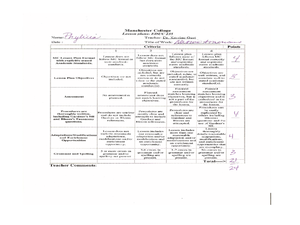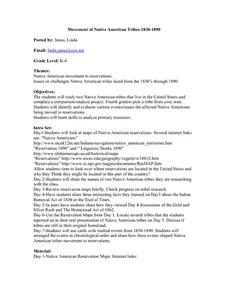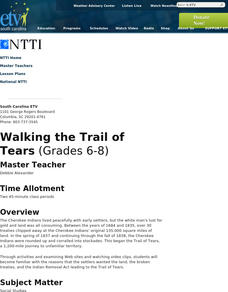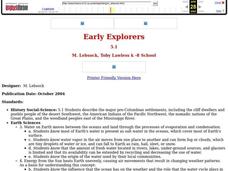Curated OER
Early Native Americans
Students create a scrapbook illustrating the culture of Native Americans that settled in the Kickapoo Valley. Working in groups, students choose a topic related to the Kickapoo Valley Indians. Using traditional and technological...
Curated OER
The Battle of Honey Springs: The Civil War Comes to the Indian Territory (68)
Learn how the Civil War created fierce conflicts among American Indian nations who had been moved across the Mississippi River.
Curated OER
Jamestown Colonies and the Powhatan Indians
Eighth graders discuss the Jamestown colony and the Powhatan Indians. In this colonial history lesson plan, 8th graders talk about conflicts between the Native Americans and the colonists. They read a biography about Pocahontas to help...
Curated OER
America: 1763-1776
For this online interactive history worksheet, students respond to 10 short answer and essay questions about the United States between the years 1763 and 1776.
Curated OER
Other Native American Groups
Fourth graders identify the three Native American groups highlighted in this lesson plan. In this Native American lesson plan, 4th graders answer comprehension questions, and classify the adaptations of the groups in a worksheet.
Curated OER
The Economienda System
Explore the Economienda System common in Latin America during the 1700s. The class will read the included text, answer 3 critical-thinking questions, and fill out a pie chart showing the demographics of the time. They will learn about...
US Citizenship and Immigration Services
Thanksgiving 2—The Pilgrim Story and My Immigrant Story
The tradition of the First Thanksgiving is really a story of immigration. Connect the feelings and customs of the early Pilgrims to the experiences of the immigrants in your class with an introduction to the 13 colonies, the Mayflower,...
Curated OER
Curriculum Guide For Teaching Texas History
Follow Texas history from Native Americans all the way to the 21st Century. Teachers analyze the creation of a year-long course on Texas history and use a wide range of teaching subjects and materials to guide them through the state's...
Curated OER
Indians in Georgia: How Do We Know What We Know?
Students discover archaeology by investigating the history of Native Americans in Georgia. In this U.S. history lesson, students participate in a mock archaeological excavation in their classroom by recovering artifacts and drawings...
Curated OER
Movement of Native American Tribes 1830-1890
Students examine the movement of Native American tribes during the mid 1800's. In this American History lesson, students study two Native American tribes that live in the United States and complete a comparison/analyze project. Students...
Curated OER
Indian Life
Students play a game to discover early California Indian life and explain their values.
Curated OER
Walking the Trail of Tears
Middle schoolers, through the use of examining video clips and Websites, become familiar with the reasons that the settlers wanted the land, broke treaties, and initiated the Indian Removal Act leading to the Trail of Tears.
Curated OER
Early Explorers
Fifth graders examine how the environment and climate affected Pre-Colombian settlements. In this civilization lesson, 5th graders view pictures of different Native American tribes in different places and discuss how different groups...
Curated OER
Trading Rendezvous
Students explore the fur trade between the settlers and Native Americans. Through class discussion, students explain and give examples of how the fur trade worked. In groups, they simulate the fur trade using materials provided by the...
Curated OER
Early Explorers
Fifth graders study early explorers. For this World history lesson, 5th graders draw an outline of a map labeling each part, build geographical features out of dough, and paint each of the land and water features.
Curated OER
Native Indian Culture: Plains Indians in Montana
Students examine the culture of the Plains Indians. In this Montana history instructional activity, students view a PowerPoint presentation regarding the social, religious, and traditional life of the Plains Indians.
Curated OER
Pocumtucks in Deerfield
As part of a study of colonial and Native American history, class members focus on the beliefs and land use of the Pocumtucks, who settled near Deerfield, Massachusetts. Students examine their beliefs about land use and ownership, the...
Curated OER
1704 Attack on Deerfield
Class groups examine conflicting primary and secondary sources describing the 1704 attack on the fort at Deerfield by French and Native Americans and analyze the implications of discrepancies.
Curated OER
Queen Anne's War and Its Impact on Deerfield
Class members read a series of primary and secondary source materials to examine the effects of Queen Anne's War, also know as the War of Spanish Succession, on the Pocumtucks and other Native Americans in the area of Deerfield, MA.
Huntington Library
Further Exploration - Exploring the California Missions
How did Native Californians and Franciscans influence one another in early California? Learners analyze a few cultural pieces to examine the impact that integration had on Franciscan and Native Californian culture.
Curated OER
Boarding Schools And Native American Culture
Students engage in a lesson that focuses on the influence of American values placed upon the Indians. Students use primary and secondary documents in order to explore the indoctrination. They create a project that reflects adequate...
Curated OER
Social Studies: How Did Native Americans Live?
Fifth graders examine Edward Curtis' photographs and Robert Griffing's paintings to analyze Native American culture. They present research information on specific tribes, using the photos and paintings to uncover information about the...
Curated OER
Early Indian Inhabitants of Deerfield
Eleventh graders explain that there is evidence of New England's being inhabited by Indians as far back as 10,000 years ago.
Curated OER
Lesson 6: Native Americans in the West
Learners recall their knowledge of Native American people who lived in the West and reflect on how their perspectives differed from pioneers and argonauts of the 19th century.

























